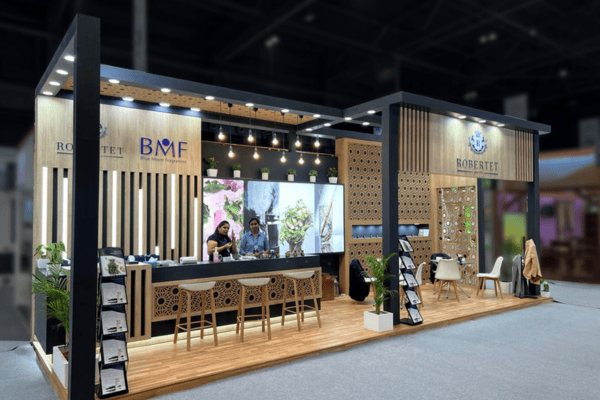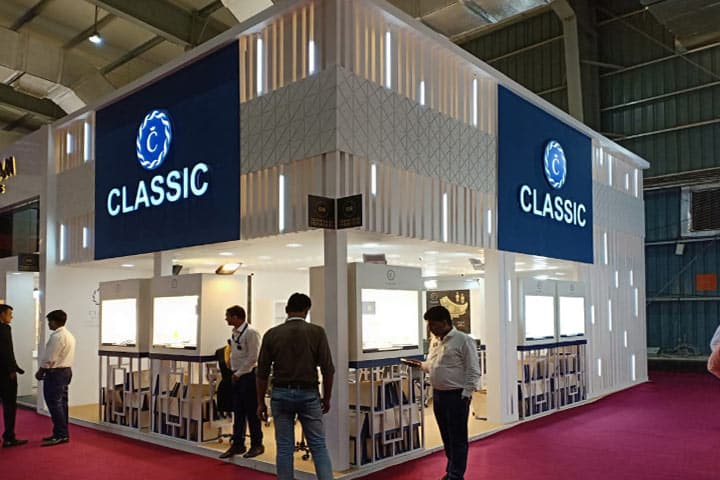Large-scale exhibitions and live events are designed to inspire — but behind every stunning setup lies a serious responsibility: safety.
Fire hazards are among the most overlooked risks in event and exhibition planning. One small oversight — a loose wire, a combustible prop, or unmonitored pyrotechnics — can lead to disastrous consequences.
As exhibition stall designers, we’ve seen how even minor lapses in fire planning, material selection, or on-site coordination can compromise not just property, but lives and brand reputation.
In this article, we’ll explore how to plan fire-safe exhibition stalls, what causes fires, and what every exhibitor should know before their next big event.
A Lesson from the Past: The Make in India Fire Incident
In February 2016, a massive fire broke out during the Make in India Week cultural event in Mumbai, right below the stage during a live performance.
Investigations revealed a disturbing pattern of negligence:
- Combustible materials were used for stage construction instead of flame-retardant panels.
- Firecrackers were stored beneath the stage, with no scientific audit during the fire inspection.
- Poor coordination between decorators, pyrotechnic teams, and safety officials.
- Lack of clear accountability between the fire brigade and police departments.
Thankfully, due to swift emergency response, no lives were lost — but the event became a stark reminder of why fire safety must be integral to stall and event design, not an afterthought.
Understanding Fire Hazards at Exhibitions
Fire risks at exhibitions arise from a combination of ignition sources, fuel materials, and oxygen. Controlling any one of these elements can prevent disaster.
Common Sources of Ignition
- Electrical overloads or faulty wiring
- Stage lighting and halogen lamps
- Pyrotechnics or fireworks
- Open flames, candles, or barbecues at food stalls
- Portable heaters and catering appliances
Common Sources of Fuel
- Non–fire-retardant display materials (cloth, foam, wood)
- Flammable paints, thinners, and adhesives
- Packaging materials and cardboard boxes
- Plastic signage and vinyl graphics
- LPG cylinders for cooking or displays
Oxygen Accelerants
- Poor ventilation or open-air wind exposure
- Oxygen cylinders or chemicals stored near display zones
- Improper storage of pyrotechnic materials
Fire Prevention Begins at the Design Stage
Fire safety doesn’t start at the venue — it starts at the drawing board.
-
Use Fire-Retardant Materials
All construction materials — from panels and fabrics to floor coverings — should be certified fire-retardant or treated for flame resistance.
At FirstRain, we follow international safety standards (NFPA, BIS, and local fire norms) for every stall build. -
Smart Electrical Planning
- Avoid overloading circuits.
- Use certified electrical fixtures and insulated cables.
- Ensure all lighting systems are professionally installed and grounded.
- Keep electrical panels accessible, not hidden behind displays.
-
Plan Emergency Access & Exits
- Design stalls with clear escape paths — never block exits for aesthetics.
- Add illuminated exit signage and mark fire extinguisher locations clearly.
- For multi-level or double-decker stalls, ensure structural and fire safety compliance from organizers.
-
Conduct Fire Risk Audits
A fire risk audit identifies ignition points, combustible materials, and evacuation challenges.
It includes:- Evaluating all potential heat sources.
- Verifying ventilation and fire-fighting access.
- Checking compliance with venue fire codes.
-
Train Your On-Site Team
Your staff should know:- Where extinguishers are located.
- How to operate them.
- Whom to call in an emergency.
Even a small training session can make a big difference when seconds count.
Emergency Preparedness & Firefighting Arrangements
- Keep fire extinguishers and sand buckets at accessible points.
- Coordinate with venue fire marshals for approvals before the event.
- Establish communication channels between stall supervisors, organizers, and emergency response teams.
- Avoid storing flammable substances beneath stages, inside stalls, or near heat sources.
Special Note for Exhibition Designers & Organizers
- When planning double-decker (mezzanine) stalls or large pavilions: Always obtain organizer and venue approval before construction.
- Confirm height and load-bearing restrictions, especially at pharma and industrial expos.
- Ensure fire exits, staircases, and railings meet safety standards.
- Compliance isn’t just a regulation — it’s a responsibility.
Partnering for Safe and Smart Exhibitions
Fire safety doesn’t have to compromise creativity. The best stall designs strike a balance — aesthetic appeal with technical precision.
At FirstRain Exhibits, we combine design innovation with uncompromising safety standards. Our team ensures that every stall is:
- Built using fire-retardant materials and certified electrical systems.
- Pre-audited for compliance before on-site installation.
- Backed by in-house fabrication, ensuring total quality control.
- Managed end-to-end, from concept to execution, for peace of mind.
About FirstRain
FirstRain Exhibits is a leading exhibition stall design and fabrication agency offering premium, turnkey solutions for brands across industries.
We design and execute world-class stalls that blend creativity, safety, and functionality — from concept sketches to on-site delivery.
We operate across all major Indian cities, including:
- Mumbai, New Delhi, Greater Noida, Bangalore, Hyderabad, and Chennai






